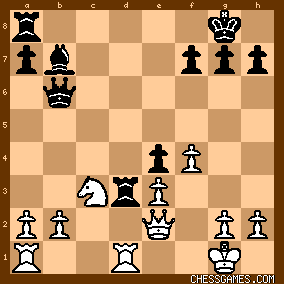KEG: Post II
Facing trouble if he tried to regain the lost pawn, von Gottschall instead tried for counter-play with: 15... Qc6
The Tournament Book award this a "!" It certainly creates complications. Another possibility was 15...Qd3?! In any case, Black cannot afford to sit back and let Pillsbury have his way. 16. cxb6
A surprisingly tame response by Pillsbury, who apparently decided that "a pawn is a pawn." But this gave von Gottschall chances. If there was a refutation of von Gottschall's ide, it lay in 16. Qd6. If then 16...Qxc5 17. QxQ bxc5 Black get the pawn back (for a moment at least) but would face assault on his weak pawns beginning with 16. Rfc1. Alternatively, if 16...bxc5 17. Rfd1 Black would again face difficulties. After Pillsbury's move, von Gottschll assumed the initiative. 16... Rfd8
17. Qe2
More surprisingly tentative play by Pillsbury. 17. Qb3 was better. 17... Qxb6
18. Rfd1 Rd3!
This left:

click for larger viewPillsbury has won a pawn but faces numerous threats. 19. RxR
Another placid move by Pillsbury that leaves him a pawn ahead but gives von Gottschall plenty of chances at attack. If he wanted to contest the initiative, Pillsbury should have tried either 19. Na4 or 19. Rac1. 19... exR
20. Qd2
He must keep an eye on his b2 pawn. The position was now: 
click for larger viewChances are now about even. But the wisdom of Pillsbury's decision to play to win a pawn was soon vindicated. This tactic might have been a recipe for trouble against Lasker, Janowski, or Marshall. But von Gottschall, though correctly fighting for counterplay, clearly did not know how to follow up his prospects, and things soon go downhill for him (though he remained very much in the game until his blunder on move 24). 20... Rd8
Not awful, but an attacking player such as Marshall would have played 20...Re8 like a shot. 21. f5
Pillsbury is reluctant to remain on the defensive, but 21. Rc1 or 21. Re1 were sounder and better. 21... Qc5
von Gottschall's instincts were correct, but 21...Re8 or 21...Bc8 were better follow-ups. 22. Qf2
The only chance to defend everything, but a fine move nonetheless. 22... f6
23. Rd1 a5
Still striving for counterplay to justify his pawn sacrifice, but 23...Qe5 or 23...Qb4 would have been more challenging for Pillsbury. 24. e4!
Pillsbury immediately leaped at the chance to exploit von Gottschall's last few tentative moves. The position was now: 
click for larger viewPillsbury has gained ground, but von Gottschall certainly still has his chances. If Pillsbury had been facing Lasker in this position, a battle royale could be predicted. But here, von Gottshcall undid all his creative play with a blunder that lost immediately: 24... Rd4??
He should have played either 24...Qb4 (as recommended by the Tournament Book) or 23...Qc6, or perhaps even 24...Qd6. But now... 25. Rxd3

click for larger viewGame over. If 25...Rc4 26. QxQ RxQ 27. Rd8+ Kf7 28. Rd7+ (ouch!) 1-0
A sad ending for von Gottschall after a game effort. | 




